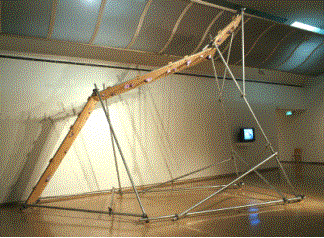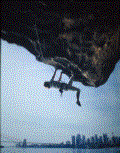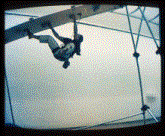'The Technological encounter; distance and proximity'
Sub-title 'Performed immediacy'
from:
'Repositioning the Landscape Viewer; Investigating Models of Appreciation and Visual Representation' Niamh O'Malley PhD 2003
Also published as part of 'Teuful' artist editions PS1 New York, 2004
'Performed immediacy'
In contrast, the corporeal experience of landscape refers to the physical movement of the viewing subject, at a human pace and with an awareness of human scale. The body becomes the only mediation between the viewer and the experience of appreciation. Speaking of a recent renewal of interest in landscape in the field of humanist geography, Cosgrave, a geographer writing from a post-modern perspective, said landscape appeared to ‘point towards the experiential, creative and human aspects of our environmental relations, rather than to the objectified, manipulated and mechanical aspects of those relations.’(1) This aspect of the discussion is set within a humanist understanding of the idea of landscape, rather than focusing on the viewing experience as one culminating in an object or physical representation. The work of Dan Shipsides, an artist who reflects the landscape mediated though the physical viewing body will be discussed.
Dan Shipsides is an artist whose work is interesting in its emphasis on the direct as opposed to the mediated experience. His works reduce the act of experience to such elemental physicality. They reinforce the durationality and aspects of physical fatigue that gives the world of tangible experience, its 'life size' (2) quality. His practice includes climbing or performance works where he undertakes to physically negotiate a landscape or an architectural space. In doing so he reinforces the scale of the body in relation to the landscape and endeavours to establish a direct relationship.
 Fig 11 Dan Shipsides, ‘Gecko Roof’, 2000
Fig 11 Dan Shipsides, ‘Gecko Roof’, 2000
Shipsides' work often involves the re-creation in a gallery of a particular famous climbing route, such as in his installation Gecko Roof, 2000, Sydney, Australia. Gecko roof is a 5 metre high 7 metre long construction which emulates the famous (but now banned) climbing route Clocks at Balls Head, Sydney. The artwork consists of a structure, which is made from scaffolding and plywood and installed in the gallery space. Climbing holds are attached to the plywood to emulate the actual climbing route.
During the exhibition in Sydney local climbers were invited to come to the gallery and navigate the route, their climbs were documented and the footage was presented for public viewing on a monitor adjacent to the structure.
The structure emulates the roof crux section of the route. With assistance from the Sydney Rock Climbing Club, research into the Clocks route was based on climbing the route and analysing its’ holds, spatiality and move sequences. A basic structure to enable the height, elevation and aspect of the route was devised using maquettes which were then developed to make the full scale structure. The holds were then attached according to the research to emulate the moves required to climb the original Clocks route.(3)
It is important to the artist that the climb is performed, by himself, and/or by climbers (as in Gecko Roof) or in some cases the ordinary gallery visitor.(4) In part the performer is negotiating the spatial problems of the gallery and in part those of a distant rock or mountain. The structures that Shipsides manufactures may be representing an enormous incline or overhang but he is limited in their representation by the architecture of the gallery space. The artist is open about this translation. His work interrogates physical and social behavioural patterns as responses to particular spaces, be they urban or rural.(5) Although Shipsides’ work derives from the history of landscape representation and negotiation, he recognises that those same actions can be used in the negotiation of constructed environments such the architecture of a gallery. In his essay ‘Knowledge by Doing’ Niels Kayser Nielsen outlines how movements cannot take place in an abstract space but ‘must take place in a space that it is possible to appropriate as a kind of balancing act between one’s movements and certain fixed points and routes in space.’(6) In other words we establish a point we want to travel towards, an objective. Shipsides describes how ‘residues of climbers chalk gives clues to the positions of usable holds and physical movements over a rock face.’(7) Participants also chronicle their climbing activities through a myriad of specialist publications.(8) Within these publications the specifics of routes are made known, reflecting our need to delineate our surroundings.
The artist also refers to the communality of the climbing experience. The chalk marks on the surface of the landscape not only mark routes but also histories of ascents and of negotiation of landscape. Climbing organisations also grade climbs according to their perceived level of difficulty. (9) This alludes to a community that not only discusses and shapes movement, but also witnesses the activity. Within the gallery Shipsides allows the climbers to gather and interact; in Gecko Roof he used a handheld video camera to document the informal social interaction between the climbers as well as individual climbs. He included footage of encouragement, jokes and technical talk as each climber performed his/her landscape experience. The body of the climber is sensing and sensed as Urry’s ‘corporeal travel’ proposes. It can be seen in contrast to the solitary viewer in the perspectival mode.
The physical movements of climbing equate to a direct form of map-making but require none of the conversions that occur in traditional mapping, none of the generalisations or transformations of scale. Kayser Nielsen says that ‘the only possibility of gaining knowledge in relation to space is through moving and/or sensory perceptions. So, gaining knowledge through space is indispensably connected with your body and its movements and perceptions.(10) Nielsen places the act of gathering knowledge about a space or transforming a space into a place, within the arena of leisure. We have already noted the position of tourism as a leisure activity which positions it in opposition to the normal working environment. Shipsides has chosen ‘climbing’, a leisure activity which also lies outside of the normal day to day movement in order to describe a particular relationship with nature. The position of ‘leisure’ is outside the realm of necessity which is the workplace. Its potential lies in its position of unpredictability and open-mindedness. We spoke previously of the passivity of much leisure activities but what Shipsides describes is a conscious and direct engagement with the natural site.
Dean MacCannell, also writing on tourism, has outlined two types of leisure activities that make use of nature, recreational and aesthetic. Aesthetic uses of nature include the act of sightseeing, of scenery and of landmarks.(11) Recreational leisure activities may include aesthetic sensibilities but they can also be separate, concentrating on nature as an arena of play. The appearance of Shipsides constructions seems to concede to this separation between the recreational and aesthetic because his concerns are evidently not strictly visual and do not immediately relate to the ‘natural image’ they describe. The materials Shipsides uses are often basic construction materials including scaffolding and plywood and the climbing holds come in gaudy day-glo colours, a far cry from the rock face. The emphasis on play positions this form of leisure as dynamic. The willingness to incorporate cultural fabrications in a discussion which is equally concerned with the natural experience counters the positioning of nature as ‘other’. The relationship between the viewing/experiencing body and nature is dialectical.
I initially characterised Shipsides’ work as placing an emphasis on the unmediated experience. What is interesting, however is the use of technological aspects which facilitate touch in the production of a direct relationship with landscape:
Various objects and mundane technologies facilitate this kinaesthetic sense as they sensuously extend human capacities into and across the external world. There are thus various assemblages of humans, objects, technologies and scripts that contingently produce durability and stability of mobility. Such hybrid assemblages can roam countrysides and cities, remaking landscapes and townscapes through their movement. Examples of such mundane technologies implicated in movement include the car, the bike, the mountain boot, the sailing boat, the snowmobile, the personal stereo and so on. (12)
Shipsides, despite appearances, is not therefore outside of the technological approach. The maps, diagrams, walking boots, his engagement with mountaineering magazines and incorporation of manufactured climbing holds into the structures etc, means that he too is engaged in a mediated technological experience, it is simply a slowed-down version. The act of climbing or mountaineering fits with Urry’s notion of the kinaesthetic sense extending human capacities into the external world. Shipsides’ works represents the ‘life-size’ experience which although multidimensional and panoramic remains a feasible experience.
Shipsides choice of Clocks was partly because of its notoriety as a banned route, his installation allowed access. He comments on this issue of access to landscape saying ‘it may represent an important debate as to the right of access (symbolic and physical) to public/private landscape in Australia for all people.’ (13) He also chose it, however, because of its incarnation as an iconic ‘image’. By doing so Shipsides highlights the importance of the image or representation in activating a landscape. The proximity of the route to the city means that a photographer can capture the Harbour Bridge and the city of Sydney in the background as someone tackles the dramatic climb. The landscape foregrounded in the image is familiarly characterised in oppositionto the humanised space in the background. The ability of the climber to overcome such a dramatic space accentuates the achievement.


Fig 12 Simon Carter ‘Catherine Destiville, Clocks’
Fig 13 Dan Shipsides ‘Gecko Roof’
The image is part of a well-known repertoire (‘the individual poised on the boundary between finite and infinite’ (14)) epitomised by the German sublime, especially Casper David Friedrich. A crucial part of this dynamic was the dissolution of the subject-object division in an attempt at oneness with nature.(15) It is interesting to look, however, at the level of separation from the original natural experience. A climber negotiated the route, a photographer represented the climb within the historical context of the sublime. Shipsides replicates this now legendary climb in a gallery space and proceeds to document a climber tackling the simulated climb through video from which is taken a ‘still’ image (illustrated above). Shipsides then presents this footage as a mirrored reflection of the original photographic image. The climb has gone from photograph to physical replication to video to still image to print. Baudrillard spoke of ‘simulation’ as more than pretending, it produces the same symptoms, signs and images as the real and so operates on a different level from the false or true.
Simulation is no longer that of a territory, a referential being or a substance. It is the generation by models of a real without origin or reality: a hyperreal. The territory no longer precedes the map, nor survives it. (16)
The original climb Clocks was chosen because of its cultural status as an iconic image and notoriety as an illegal route. Despite Shipsides relationship with the unmediated experience it is hard to know where the ‘real territory’ lies within his work.
From walking to running
According to Jonathan Crary, Walter Benjamin’s writing allowed us to encounter:
an ambulatory observer shaped by a convergence of new urban spaces, technologies and new economic and symbolic functions of images and products – forms of artificial lighting, new use of mirrors, glass and steel architecture, railroads, museums, gardens, photography, fashion, crowds. Perception for Benjamin was acutely temporal and kinetic; he makes clear how modernity subverts even the possibility of a contemplative beholder. There is never a pure access to a single object; vision is always multiple, adjacent to and overlapping with other objects, desires and vectors. Even the congealed space of the museum cannot transcend a world where everything is in circulation. (17)
Shipsides work is most importantly positioned as part of a mobile rather than a static gaze. A primary factor in the works reference to movement is touch. When Urry describes the kinaesthetics of the body he is talking about a sixth sense that informs one what the body is doing in space through the sensations of movement registered in its joints, muscles, tendons and so on. Touch is particularly important to a sense of movement, the touch of feet on a path or hand on a rock-face when climbing. Shipsides’ proposed participant is representative of the moving viewer rather than the ‘contemplative beholder’ who nevertheless remains attentive to the functions and actions of bodily movement. If we take Benjamin’s and Shipsides’ ‘ambulatory observers’ (the word “ambulatory” is crucial) they remain at walking pace, able to observe according to their bodily movement. If we, however, accelerate the pace of the observer and of the technologies that surround him/her, we have a sense of new challenges as well as new potentiality in the field of appreciation. This accelerated contemporary viewer is dealing with compound multiples prompted by rapid developments in multimedia technologies. According to Benjamin ‘the body looses its corporeality’ (18) in relation to such experiences.
Dr. Niamh O'Malley 2003
1 Richard Muir, Approaches to Landscape (London: MacMillan Press, 1999), p. xviii.
3 Dan Shipsides, Unpublished Writings, 2003
Blood Cell Sequence, Smart Project Space, Amsterdam, 2002, ‘anyone could climb whenever they liked - and change the holds around to make their own routes and problems. None of the other works had signs to say do not climb but some galleries had insurance issues so invigilators are ordered to intervene if anyone got too close.’ Dan Shipsides, Unpublished Writings, 2003.
5 In the video work ‘Swammerdam Groove’, the artist documented a series of climbs throughout a building in central Amsterdam. ‘The route reveals and reclaims the building by exploring its spaces many of which have become derelict through disuse.’ Dan Shipsides, Unpublished Writings, 2003.
7 Dan Shipsides, Unpublished Writings, 2003.
8 See: Irish Mountain Log, Mother Rock Magazine, Mountain Online, Planet Mountain.com TopRope.com, Climbing magazine and Gripped.
9 The artist refers to the Clocks route as a hard climbing problem with an Australian climbing grade of 22 and United Kingdom grade of 6b, Dan Shipsides, Unpublished Writings, 2003
10 Niels Kayser Nielsen, ‘Knowledge by Doing’ in Leisure/Tourism Geographies ed. by David Crouch (London: Routledge, 1999), p. 278 .
11 Dean MacCannell, The Tourist (California: University of California Press, 1999), p. 80.
12 John Urry, The Tourist Gaze, pp. 152-3.
14 See: Simon Morley ‘The Friedrich Factor’, Contemporary Visual Arts, 19, 26-33
15 Ibid. p. 28.
16 Jean Baudrillard, Selected Writings, p.166.
17 Jonathan Crary, Techniques of the Observer, (Cambridge MA, MIT Press, 1992) paperback, p. 20.
18 Walter Benjamin Illuminations, (London, Fontana Press, 1992) p. 223.